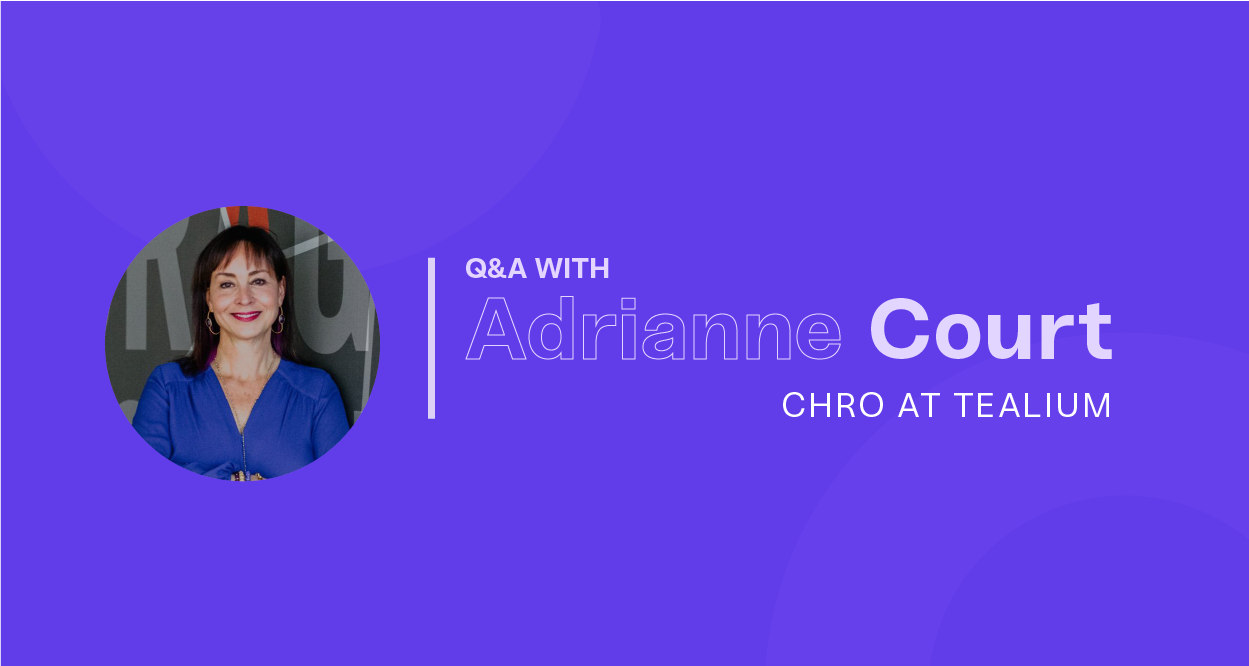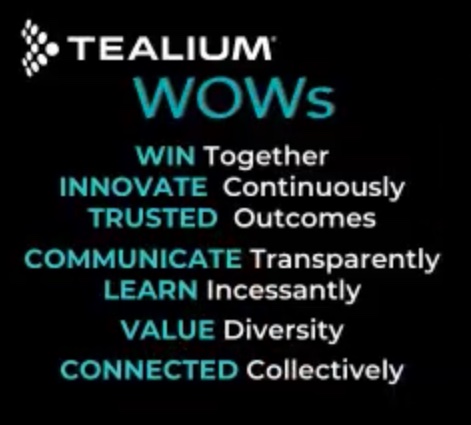
Adrianne Court is Chief HR Officer at Tealium, the #1 most trusted customer data platform. Adrienne also has the distinction of being named a 2nd Annual People Pioneer, honoring her work as a forward-thinking HR leader who has driven impact with people-first strategies.
Read on to learn what it takes to build a people-first People program.
ChartHop: What are your responsibilities at Tealium?
Adrianne Court: My title is Chief HR Officer, which is very intentional. When they did the search for this job, they titled it CPO. When I joined, I changed it to CHRO. And why I think that’s important is because in my role, while I do lead things for people, it’s not always about the people. We have to do a lot of things in order to support the business and make it efficient. So not everything is specifically to the benefit of people. Also, ‘people’ suggests one thing. But Human Resources is the entire spectrum.
In my role, I lead all HR programs, which is a spectrum from Talent Acquisition to the experiences within the organization to leaving Tealium. So that’s everything from benefits, compensation, all elements. And then most importantly, the wrap around all of that is culture. Many people say my primary responsibility is culture, but everything I do wraps around and reinforces culture.
CH: You were part of leading Tealium through a transformative year, which included ensuring the culture remained intact. Why was it important that culture remained intentional as the company scaled?
AC: Sometimes when you’re an early stage company, culture just kind of happens because you’re all together and interact closely with one another. But then as you grow and evolve, it becomes harder to maintain that same connectivity. Particularly for us at Tealium, we’re now in 17 countries with nearly 750 team members. Creating that super intentionality around culture is really important otherwise you lose your way.
Before I officially onboarded, I facilitated a culture session with the leadership team to understand what is the culture? What are the words we use, what is the consistency, what do they want it to be, and what are they concerned about? And then from there, I helped articulate it into what we call ‘Tealium WOWs (Ways of Work)’ and reinforce it into everything we do.

From our internal communications, to our rewards and recognition, to our DEI programs, to our well-being programs, to our learning and people development programs, everything ties back to our culture.
Culture is super important. People tend to think of culture as the warm-and-fuzzies, but it’s not. It’s the foundation of how you work and operate together. If you don’t have that, then you’re left with an inconsistent experience. So culture is simply how you:
So as it applies to my work at Tealium, I didn’t change the culture. What I did was I listened, encapsulated it, articulated it, helped us put it into action, and from there helped us connect with our customers and our community.
CH: Can you speak more about Tealium WOWs? What went into developing an award-winning culture? Who was involved in the process?
AC: When it came to crafting Tealium WOWs, I started with what was already in place and listening to the language that already existed. Then I did a culture survey asking the executive and leadership team how they would articulate the culture, in which areas they saw our culture was really vibrant, and what areas of our culture they would want to develop.
After capturing all of their feedback, I hosted a working session using the red dot/green dot technique to align where our culture currently was and where we wanted it to be. For example, ‘winning’ was a word that was used a lot throughout the organization, since a lot of the founders have a background on sports teams. But a lot of people see winning as innately adversarial – someone wins and someone loses. During the conversation in the working session, we created the pairing of “Win Together”, which means we take all of the great things that each one of our positions brings to win together.
It’s been a year since rolling out Tealium WOWs and at a recent all company quarterly meeting, I was excited to see how they’ve been adopted, with every one of our executives referencing WOWs at some point. At least twice a week, I meet 1:1 with team members at all levels of the organization and it’s amazing how many talk about our culture. They tell me they believe in it and they feel it’s reinforced because we talk about it and hold ourselves accountable to it.
CH: Under your leadership, eNPS survey results increased from 26 to 37 in just a year, incredible! When you initially saw that there was room for improvement, what steps did you take to improve the employee experience and increase engagement?
AC: Once we got the Tealium WOWs done, we mapped out the areas that were important to our teams and important to the foundation of our growth. When I joined Tealium, the sense was that we weren’t an organization that was open to listening and learning, both of which are critical to diversity, equity, inclusion, and belonging.
So right off the bat, we were observing Black History Month at Tealium and I wanted to create space for listening and learning. I grew up in a town in Southern California that had the KKK actively walking the streets and I have since come to realize that I was a bystander. I invited one of my then high school classmates who is now a good friend and professor, Daniel Walker, to partake in a conversation to discuss our same shared, but very different experiences in that environment. My ability to be vulnerable in a public forum started to create that opening of having those conversations that cultivate listening and learning. That is what really improved our DEI scores. People feel like their voice will be heard and they can share their stories.
Fundamentally, we also saw an opportunity to really invest in our managers and leaders. We’ve all heard, “People don’t leave bad jobs, they leave bad managers.” And so, we really wanted to prioritize investing in our managers and leaders. We implemented what we call BOOST manager training, which are monthly conversations that cover the basics like how compensation works, how to have performance review conversations, and how to manage remote teams.
We also created a leadership development program that allows our employees to develop their leadership skills and learn about different functional areas by pairing them with one of 25 participating leaders. This program really elevated the conversation and increased accountability for leadership, which has led to most scores around managers and leaders improving significantly.
CH: You’re also introducing an Employee Assistance Program (EAP) to provide all Tealium employees with resources in the countries where they work. How did you identify that there was a need that led to the creation of this initiative? Why did you and the extended executive team feel it was important to address now rather than at a later date?
AC: When we did our engagement survey, Tealium’s approach to remote working, which we call Tealium Connects, was our highest score by far. But when we really dug into the 6,000+ comments and categorized the themes, it hinted at challenges of isolation and mental well-being. Although we had already created ‘Healium’, which is our well-being program that offered EAPs in some countries but not all, it became clear that the experience was inconsistent across regions and we were not able to have a single resource for our employees globally that also had their local language.
Fortunately, there are so many remarkable EAPs on the market today and we were able to find one that supports every country in the languages that we needed. Going beyond just a referral program, our chosen EAP will help us put on seminars and various learning programs. We’re so excited to officially launch this month!
CH: What does being a people-first People leader mean to you?
AC: You almost have to have a split personality. You have to be a culture champion, living and reinforcing the culture and ensuring it touches everything internally and externally. You also have to be a business person and speak the language and understand how the business makes money and loses money. Every conversation you’re a part of can’t be about culture. Being a people-first People leader means being able to speak to the ROI of people programs. You have to balance both really well.
CH: What excites you most about the future of HR?
AC: I think that many companies and organizations have opened their eyes to the importance of investing in the fundamentals of culture, their people, and diverse groups and perspectives. That’s what’s mind-blowing and super cool about where we are today.
With that, there are the challenges with remote working and as CHROs and CPOs, we haven’t yet thought a lot about what that means in terms of skillsets. We’ve largely moved to remote working, but we haven’t really trained employees or given them the tools to be successful. When we think about leadership training, there are some leaders who instinctively are great leaders and figure it out. For the majority, however, we have to spend time training them and giving them the fundamentals of how to do it well. Remote working is the same thing. Certainly, some instinctually have figured it out and can do it. But we really haven’t spent the time on training our people to be successful working remotely. They all say they want to do it but how do we help them be successful? How do we help them prioritize their workload or manage isolation and all the conflicts that come with being at home? How do we enable employees to demonstrate performance when they’re not connected on a day-to-day basis with their managers? There’s a lot of things that we as CHROs need to be challenged with in terms of really making remote working successful. That’s going to be a fun one!
Interested in even more lessons learned from senior HR leaders? Check out the full list of 2nd Annual People Pioneers and read more about the people-first initiatives they implemented to drive impact through creating a connected team, growing intentionally and sustainably, implementing wellness benefits, and much more.
Get the publicationSign up for a free demo today.